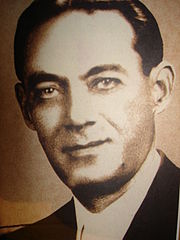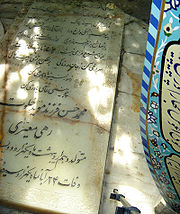
Rahi Mo'ayeri
Encyclopedia
خ


 Rahi Mo'ayyeri was a famous contemporary poet and musician from Iran
Rahi Mo'ayyeri was a famous contemporary poet and musician from Iran
.
He was born on April 30, 1909 in Tehran
. He came from an artistic family his uncle was a famous Qajar Era poet Foroughi Bastami. Arts, and music were always present in his home. He became familiar with painting and music as a child, began to write poetry when he was seventeen years old, and chose Rahi as his pen name. He showed unbelievable talent from an early age and wrote the famous "Shod Khazan" at the age of 12-13. At an early age he started Rahi had studied the works of all the great masters of Persian literature, but was especially fond of Saadi, whose influence is readily visible in Rahi’s poetry. In addition to qazals, he also wrote some masnavis.
Rahi was a composer as well as a poet. His poetry combines beautiful imagery, eloquence, and delicacy of expression. These qualities and his deep understanding of Persian music made him the poet of choice for all the great composers of his time. Rouhollah Khaleghi and Rahi met in 1941, and from this point on, Rahi wrote the lyrics for most of Khaleghi’s compositions as well as those of Morteza Mahjoubi, Ali Tajvidi, Hossein Yahaqqi, Moussa Maroufi, and Javad Maroufi. Master R.Khaleghi said that he was especially impressed with Rahi’s ability to fit words to music. Rahi’s poems have been published in Saye-ye Omr Sayeh Omr (سايه عمر in Persian) (translated "The Shadow of Life") (1964), Azadeh (1974), and Javdaneh Rahi (1984). Rahi had a deep and great friendship with Mr. Davood Pirnia (the starter of Golha Program) and due to that friendship he did a lot of work with Morteza khan Mahjoubi in the golha programs. Many believe that the late 1950s and 1960s were the golden age of Persian music after the resignation of Mr. Pirnia. Rahi reluctantly accepted to run the golha program till his illness. He was a very well dressed man with stunning green eyes. He never married. The former shah's mother and the late shah were big fans of Rahi Moayeri's work and because of that he was very influential in the Pahlavi regime but he never once abused his influence. He was a very selfless man and did not even want to publish his book. He always said that his poems will not compare to the old masters. He also wrote many comic poems under many pen names. One of his last works was Golhayeh Rangarang #470 that was song By the Late Haydeh and music was by the late Master Tajvidi (Many claim that this is the song that made Haydeh famous).
His book Sayeh Omr (سايه عمر in Persian) (translated "The Shadow of Life") of poems was printed in 1964.
He died on November 15, 1968 in Tehran
and was buried in the Zahir o-dowleh cemetery in the northern parts of Tehran
.
He was the son of Mohammad Hassan Khan Mo'ayeri.



Iran
Iran , officially the Islamic Republic of Iran , is a country in Southern and Western Asia. The name "Iran" has been in use natively since the Sassanian era and came into use internationally in 1935, before which the country was known to the Western world as Persia...
.
He was born on April 30, 1909 in Tehran
Tehran
Tehran , sometimes spelled Teheran, is the capital of Iran and Tehran Province. With an estimated population of 8,429,807; it is also Iran's largest urban area and city, one of the largest cities in Western Asia, and is the world's 19th largest city.In the 20th century, Tehran was subject to...
. He came from an artistic family his uncle was a famous Qajar Era poet Foroughi Bastami. Arts, and music were always present in his home. He became familiar with painting and music as a child, began to write poetry when he was seventeen years old, and chose Rahi as his pen name. He showed unbelievable talent from an early age and wrote the famous "Shod Khazan" at the age of 12-13. At an early age he started Rahi had studied the works of all the great masters of Persian literature, but was especially fond of Saadi, whose influence is readily visible in Rahi’s poetry. In addition to qazals, he also wrote some masnavis.
Rahi was a composer as well as a poet. His poetry combines beautiful imagery, eloquence, and delicacy of expression. These qualities and his deep understanding of Persian music made him the poet of choice for all the great composers of his time. Rouhollah Khaleghi and Rahi met in 1941, and from this point on, Rahi wrote the lyrics for most of Khaleghi’s compositions as well as those of Morteza Mahjoubi, Ali Tajvidi, Hossein Yahaqqi, Moussa Maroufi, and Javad Maroufi. Master R.Khaleghi said that he was especially impressed with Rahi’s ability to fit words to music. Rahi’s poems have been published in Saye-ye Omr Sayeh Omr (سايه عمر in Persian) (translated "The Shadow of Life") (1964), Azadeh (1974), and Javdaneh Rahi (1984). Rahi had a deep and great friendship with Mr. Davood Pirnia (the starter of Golha Program) and due to that friendship he did a lot of work with Morteza khan Mahjoubi in the golha programs. Many believe that the late 1950s and 1960s were the golden age of Persian music after the resignation of Mr. Pirnia. Rahi reluctantly accepted to run the golha program till his illness. He was a very well dressed man with stunning green eyes. He never married. The former shah's mother and the late shah were big fans of Rahi Moayeri's work and because of that he was very influential in the Pahlavi regime but he never once abused his influence. He was a very selfless man and did not even want to publish his book. He always said that his poems will not compare to the old masters. He also wrote many comic poems under many pen names. One of his last works was Golhayeh Rangarang #470 that was song By the Late Haydeh and music was by the late Master Tajvidi (Many claim that this is the song that made Haydeh famous).
His book Sayeh Omr (سايه عمر in Persian) (translated "The Shadow of Life") of poems was printed in 1964.
He died on November 15, 1968 in Tehran
Tehran
Tehran , sometimes spelled Teheran, is the capital of Iran and Tehran Province. With an estimated population of 8,429,807; it is also Iran's largest urban area and city, one of the largest cities in Western Asia, and is the world's 19th largest city.In the 20th century, Tehran was subject to...
and was buried in the Zahir o-dowleh cemetery in the northern parts of Tehran
Tehran
Tehran , sometimes spelled Teheran, is the capital of Iran and Tehran Province. With an estimated population of 8,429,807; it is also Iran's largest urban area and city, one of the largest cities in Western Asia, and is the world's 19th largest city.In the 20th century, Tehran was subject to...
.
He was the son of Mohammad Hassan Khan Mo'ayeri.
See also
- Persian literaturePersian literaturePersian literature spans two-and-a-half millennia, though much of the pre-Islamic material has been lost. Its sources have been within historical Persia including present-day Iran as well as regions of Central Asia where the Persian language has historically been the national language...

